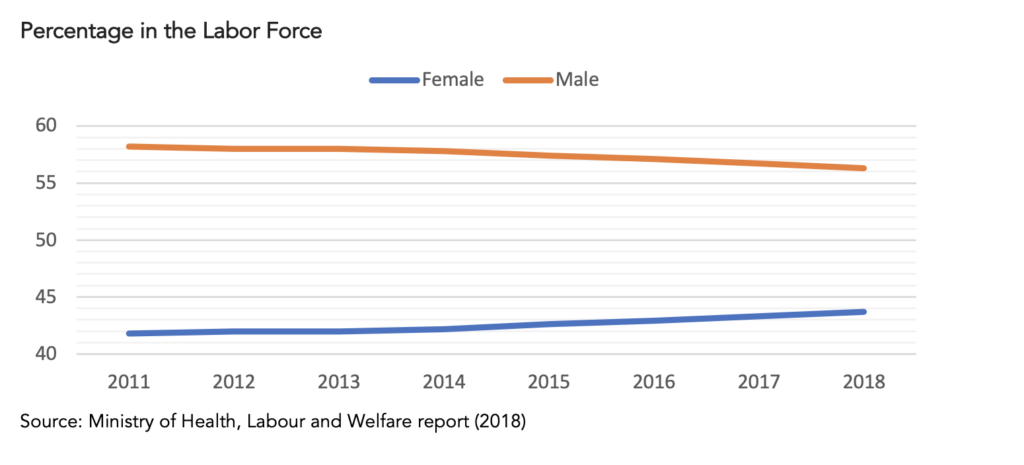
In highly-diverse societies such as the United States or Europe, talk of “diversity” in the labor force has been around for a long time. In Japan, the issue is rather different, to put it mildly.
Diversity is certainly not the strongest aspect of Japan’s labor market. There is a long history of local tradition, work culture and institutions that have inhibited the shift from a uniform working class to one that is more diverse.
You will notice a certain dispersion in the male – female, or foreigner – Japanese, employee ratio for various sectors of the economy. What you see in the construction industry will obviously contrast with the apparel sector; while the taxi business will exhibit a stark contrast compared to the hospitality sector.
If we put aside the recent upheavals caused by Covid-19, then we noticed that over the past decade various sectors of Japan’s economy have clearly exhibited a tendency towards more diversity. Today, there are many more young leaders, female employees, foreign nationals, as well as gender identity individuals working than just a few years ago.
The problem, however, is that (as demonstrated in the graph below) this process is proceeding at a glacial pace and the situation is still far from ideal.

Japan’s energy market and, particularly, the renewable energy sector, is not an exception. According to official statistics, females make up just 14.3% of the labor force in the electricity, gas, heat supply and water sectors (as of 2019). In such sectors, the difference in diversity from company to company becomes even more conspicuous.
Less diverse and agile organizations risk being labelled as maru-dome, which signifies that they are “too domestic”, “old fashioned” and dominated by overly conservative, male-only leaders. Recruitment agencies hear such descriptions from their network of candidates on a daily basis.
Here are a few case studies that are indicative of the changing and challenging labor market in terms of diversity and perceptions. Recently, Company A invited a young female candidate to the first, supposedly “casual” interview. The lady met with 3 interviewers, all male, in their late 40s-early 50s. They posed a list of classic, official interview questions, while providing very little information from their side.
Not surprisingly, the candidate left with the impression that Company A has a very traditional work culture, which means it is a male dominant, hierarchy-based organization, where staff are expected to remain until retirement.
Another example involves a company where HR by default required three resumes: a short and an extended version of the Japanese resume, plus an English one. This is despite the fact that the hiring manager is a fluent English speaker and competing companies only require an English resume for the same position. It’s common to see some excellent candidates lose interest based on that requirement alone. If the job application process is so rigid and traditional, what are the chances the rest of the company’s processes are modern and efficient?
Corporate culture is hard to change without inspiring role models. To attract such calibre of talent, however, requires a willingness to do things differently, overcoming entrenches attitudes and thought patterns.
Despite some underlying risks, a diverse and inclusive environment helps create a more healthy, efficient, and hence, competitive business. Companies that fail to do so, not only miss out on abstract benefits, but often risk getting hit by a very tangible loss.
So, what can business do about it?
- Since every organization is different, there’s no magic solution. However, as a first step you can definitely raise awareness internally and encourage employees’ attention to the issue of diversity. Perhaps some companies can clearly state internally or externally that they have goals to reach a certain level of females or young people within their leadership teams. Others might promote workshops for their employees or hold “awareness weeks”.
- Hire or nurture your own role models! You can either hire externally or empower someone internally. For example, one of the global energy companies that’s long been established in Japan only had Japanese men in its leadership team. But this company was very glad to find an overseas born female leader to join their team. She became a role model for other, more junior, female employees in the organization. Meanwhile, another company approached this matter by promoting internally a young, energetic and prominent employee.
Set a clear goal and move forward with small steps. Diversity doesn’t happen in a day and requires long-term commitment to the goal and effort. We’ve seen some companies set up a system in which at least one of their three job interviewers are female.
Similar targets can be set for gender diversity of candidates called up for the first interview. Still other companies have created quotas for underrepresented groups of employees to make them more visible and more likely to seize their opportunity to shine.
Slowly but surely, diversity is winning over the “old ways”. But as far as Japan is concerned, a lot more work can and needs to be done. The benefits of change are sure to follow.
RIKU OGAWA is the Japan Executive Search & Market Entry, Manager for Titan GreenTech
This article originally appeared in a Japan NRG Weekly report. Japan NRG is a one-stop platform that delivers both intelligence and analysis on energy and electricity markets in Japan.


